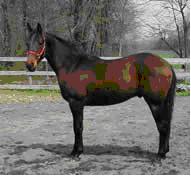Anglo-Arabian
N/A
Mon, 28th April, 2025 - 10:04 am GMT
Sponsor Ads:

Alternative Name
N/ABasic Info
As a result of the different crosses that can be made to produce an Anglo-Arabian, their size and appearance is variable. The largest horses are usually produced by breeding a Thoroughbred mare to an Arabian stallion. The best examples of this breed inherit the endurance and stamina of the Arabian, and the speed and scope of the Thoroughbred. The horses are usually 15.2-16.3 hands high, and mainly chestnut, bay or brown. The best of the breed have more of a Thoroughbred-type conformation, with a long neck, more prominent withers than the Arab, a short and strong body, more sturdy than the Thoroughbred, and a deep chest. It should not look like a Thoroughbred, nor an Arabian. They have fine heads, although not overly dished in profile, and have strong bone
Health
N/AHabitat
ArabiaBehavior
The breed is also excellent at eventing, with the stamina, jumping ability, and speed needed for this demanding sport. Sweet natured, elegany horseOrigin
France and ArabiaHistory
The Anglo-Arabian horse is just what its name implies: a Thoroughbred (prefix Anglo) crossed with an Arabian horse. The cross can be made between a Thoroughbred stallion and Arabian mare, or vice-versa. It can also be a cross between a Thoroughbred and an Anglo-Arab, an Arabian and an Anglo-Arab, or between two Anglo-Arabians. This produces a cross that is generally more substantial than a pure-bred Arabian. No matter what the cross, the Anglo-Arabian must have at least 25 percent Arabian blood to be considered an Anglo-Arabian. France has been one of the greatest producers of Anglo-Arabians. The French Anglo-Arabian has traced back to two stallions: Massoud (an Arabian), and Aslam (a Turkish horse). Imported from Syria, they were crossed with three imported English Thoroughbreds: Comus Mare, Daer, and Selim Mare. Their three daughters, Clovis, Danae, and Delphine became the foundation stock of France's breeding program.Common Foods
grassSponsor Ads:
"He burns his boats and breaks his cooking-pots; like a shepherd driving a flock of sheep, he drives his men this way and that, and nothing knows whither he is going." -- Sun Tzu, The Art of War
Anglo-Arabian
Coded by: BGID® | ALL RIGHTS RESERVED Copyright © 2000-2025
Disclaimer | Privacy | Report Errors / Contact | Credits








 Why haven't we as a collective earth met with aliens yet?
Why haven't we as a collective earth met with aliens yet?  The Best Text Adventure You Will Ever Play! The official site:
The Best Text Adventure You Will Ever Play! The official site:  Homosexual behavior stems from the mind or genetics?
Homosexual behavior stems from the mind or genetics?  World EcoSystem - Biodiversity Changes - Who is on board and who isn
World EcoSystem - Biodiversity Changes - Who is on board and who isn  Mouthwash - Mouthrinse - Mouth Sores - Healing Infections - Gingivitis
Mouthwash - Mouthrinse - Mouth Sores - Healing Infections - Gingivitis  Treatment for Depression
Treatment for Depression  Ultra radical and violent Islamist group that even rivals Al Qaeda
Ultra radical and violent Islamist group that even rivals Al Qaeda  An idea to have teachers who want to carry guns to school undergo some level of police training will be left up to local school districts and police departments.
An idea to have teachers who want to carry guns to school undergo some level of police training will be left up to local school districts and police departments.